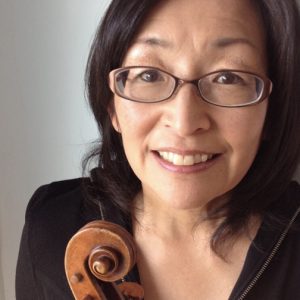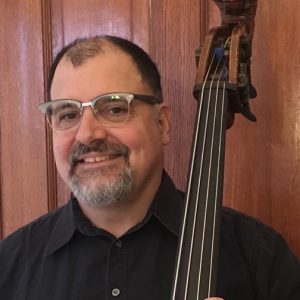On Wednesday, July 7 at 12:10 p.m., the Free Admission Glendale Noon Concerts program will be streamed. Violinist Lori Ashikawa and bassist Michael Hovnanian will perform duos by Maurice Ravel, Lee R. Kesselman and Theodor Albin Findeisen on a Facebook stream and on YouTube.
The selections “Duo pour Violon et Violoncelle” by Maurice Ravel (arranged by Michael Hovnanian), “Bagatelle 2 for Violin and Double Bass” by Lee R. Kesselman and “Romantische Suite, Op. 10, for Violin and Double Bass” by Th. A. Findeisen will be presented.
Lori Ashikawa hails from Pasadena where she studied violin with Alice Schoenfeld at the University of Southern California, and was a member of the Long Beach Symphony. Ashikawa now lives in Chicago where she has performed with the Joffrey Ballet, Chicago Opera Theater, Music of the Baroque, Chicago Symphony, Fulcrum Point New Music Project, and Goodman and Steppenwolf Theaters. Ashikawa studied period violin with Elizabeth Blumenstock in San Francisco, and Sayuri Yamagata and Shunske Sato in Amsterdam and she performs on Baroque violin with the Haymarket Opera Company and Ars Antigua. When she puts the violin down, Ashikawa studies the shamisen (three-string Japanese lute) with legendary jazz bassist Tatsu Aoki.

Michael Hovnanian grew up in the Seattle area. His primary teachers were James Harnett and Ronald Simon of the Seattle Symphony. He also studied with Frederick Tinsley of the Los Angeles Philharmonic at California Institute of the Arts, where he received a Bachelor of Fine Arts degree. From 1989-2019 he was a member of the Chicago Symphony Orchestra, serving under music directors Sir Georg Solti, Daniel Barenboim, and Ricardo Muti. He is currently an instructor of double bass at DePaul University in Chicago and works as a freelance musician in the Chicago area.

Ashikawa and Hovnanian live with their two cats Taro and Hinoki, who are thrilled that they haven’t been on vacation for over a year. (Lori and Michael are less thrilled.)
__________________________________
In 1920, regarded as one of the leading composers in France, Ravel was invited to submit a composition to the magazine, “La Revue musicale,” to be included in a special musical supplement commemorating Claude Debussy, who had died two years earlier, in 1918. Between 1920 and 1922, Ravel wrote three additional movements of what would eventually become the “Sonata for Violin and Cello.” The work shows influences of Kodály and Bartok, as well as Debussy. Ravel considered it a turning point in his evolution as a composer. He wrote, “The music is stripped to the bone, harmonic charm is renounced, and there is an increasing return of emphasis on melody.”
Lee Kesselman is a Chicago-area composer/conductor who is professor and chair of Music at College of DuPage. He has written well over 100 works in virtually all acoustic genres. Of “Bagatelle 2,” he writes, “’Bagatelle 2’ was one of two short solo piano bagatelles written in 2012. In 2016 it was re-arranged for solo violin and solo double bass. Both bagatelles explore simple musical forms and limited musical materials. ‘Bagatelle 2’ is written in a simple ABA, or three part, form with the first part containing the opposition of an ‘electronic graffiti’ ostinato figure in the bass against a sustained melodic line in the violin, enhanced by double-stops in thirds. In the final section, the roles reverse, with the bass playing in unison against the violin ostinato. In the middle section, the two instruments combine to form a more expressive and dissonant duet in which both instruments are melodic and more equal partners. This performance marks the premiere of ‘Bagatelle 2’ in its violin/bass version.”
Theodor Findeisen was a noted German double bassist, pedagogue and composer. He was a bassist in orchestras at Köthen, Breslau, and Leipzig, where he eventually became solo double bassist of the Gewandhaus Orchestra. His works, particularly his etudes and method books, are popular among double bassists today. “The Romantic Suite” is in four movements, each having an evocative title. I. “Am Birkenwald” (“In the Birch Wood”), II. “Nachtlicher Marsch de Gnomen” (“Night March of the Gnomes”), III. “Unterm Haselbusch” (“Under the Hazel Bush”), IV. “Erlauscht” (“Overheard”).
More information about the program and artists, and the link to the stream, can be found at http://glendalenoonconcerts.blogspot.com.
For more information, email glendalesda@gmail.com or call (818) 244-7241.
